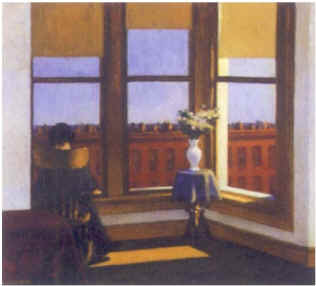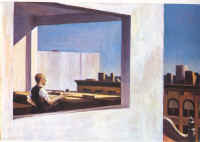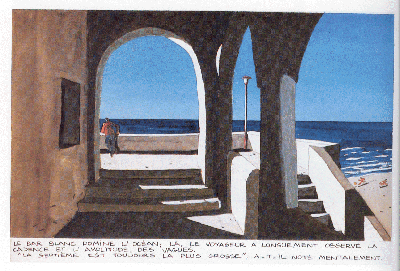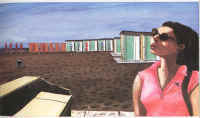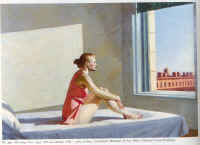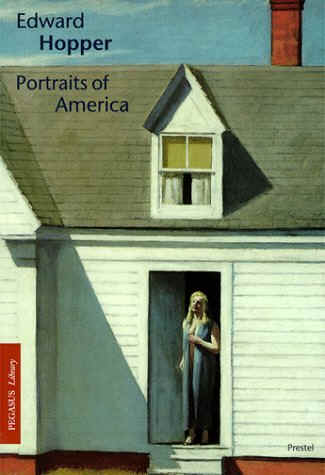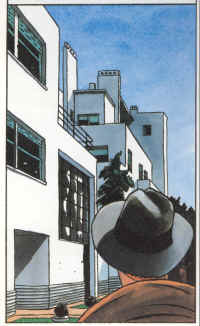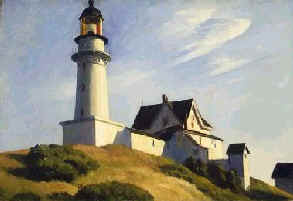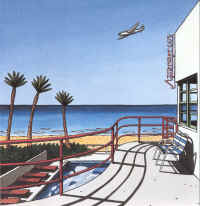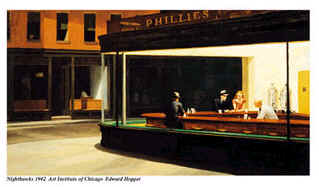"Art Loustal" : Jacques de Loustal / Edward Hopper
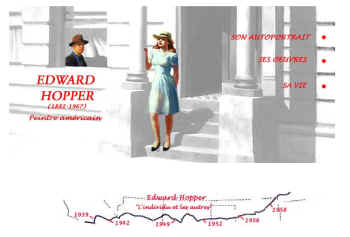 Edward Hopper website (f) 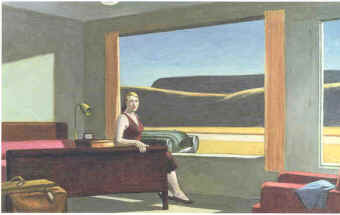 Edward Hopper: Western Motel, 1957
Edward Hopper Oversize book of works. |
Loustal: Je préfère les
peintres instinctifs et figuratifs. Les peintres du début du siècle
Matisse, Modigliani, Gauguin. Tous les peintres allemands de " la
nouvelle subjectivité ", Beckmann, Grosz, Otto Dix. Et bien sûr, Hopper,
Hockney, Balthus, pour l'immobilisme.
Ce bleu califormien vient tout droit de chez Hockney, mais le personnage solitaire sur la terrasse appartient plutôt à Hopper. Loustal, Arrière saison page 17, fragment (technique mixte),© Albin Michel, 1985. Dieses kallfornische Blau Ist eindeutig von Hockney inspiriert die einsamen Figuren auf der Terrasse jedoch eher Hopper zuzuordnen.Loustal, Arrière saison, Seite 17, Ausschnitt (Mischtechnik), © Albin Michel, 1985. The Califfornian blue is deflinitely inspired by Hockney where as the the estranged figures on the terrace cire in reference to Hopper. Loustal, Arrière saison, page 17, detail (mixed media), © Albin Michel, 1985.
|
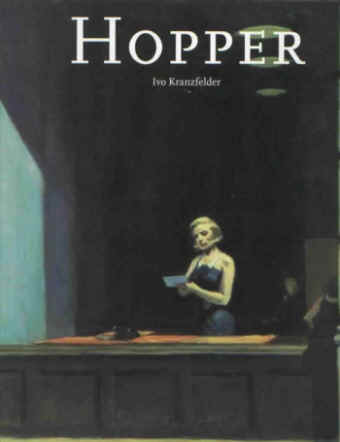 Hopper by Ivo Kranzfelder, hardcover with dustjacket, 200 pages,9 3/4 x 12 inches, Publisher: TASCHEN America Llc; (November 1998), ISBN: 3822872105 From the dustjacket: Edward Hopper (1882 - 1967) is considered the first significant American painter in twentieth-century art. After decades of patient work, Hopper enjoyed a success and popularity that since the 1950s have continually grown. Living in a secluded country house with his wife Josephine, he depicted the loneliness of big-city people in canvas after canvas. Probably the most famous of them, Nighthawks, done in 1942, shows a couple seated quietly, as if turned inwards upon themselves, in the harsh artificial light of an all-night restaurant. Many of Hopper's pictures represent views of streets and roads, rooftops, abandoned houses, depicted in brilliant light that strangely belies the melancholy mood of the scenes. Hopper's paintings are marked by striking juxta-positions of color, and by the clear contours with which the figures are demarcated from their surroundings. His extremely precise focus on the theme of modern men and women in the natural and man-made environment sometimes lends his pictures a mood of eerie disquiet. In House by the Railroad, a harsh interplay of light and shadow makes the abandoned building seem veritably threatening. On the other hand, Hopper's renderings of rocky landscapes in warm brown hues, or his depictions of the seacoast, exude an unusual tranquillity that reveals another, more optimistic side of his character. Over 200 illustrations, most in full color make this a must have book for the Hopper fan.
|
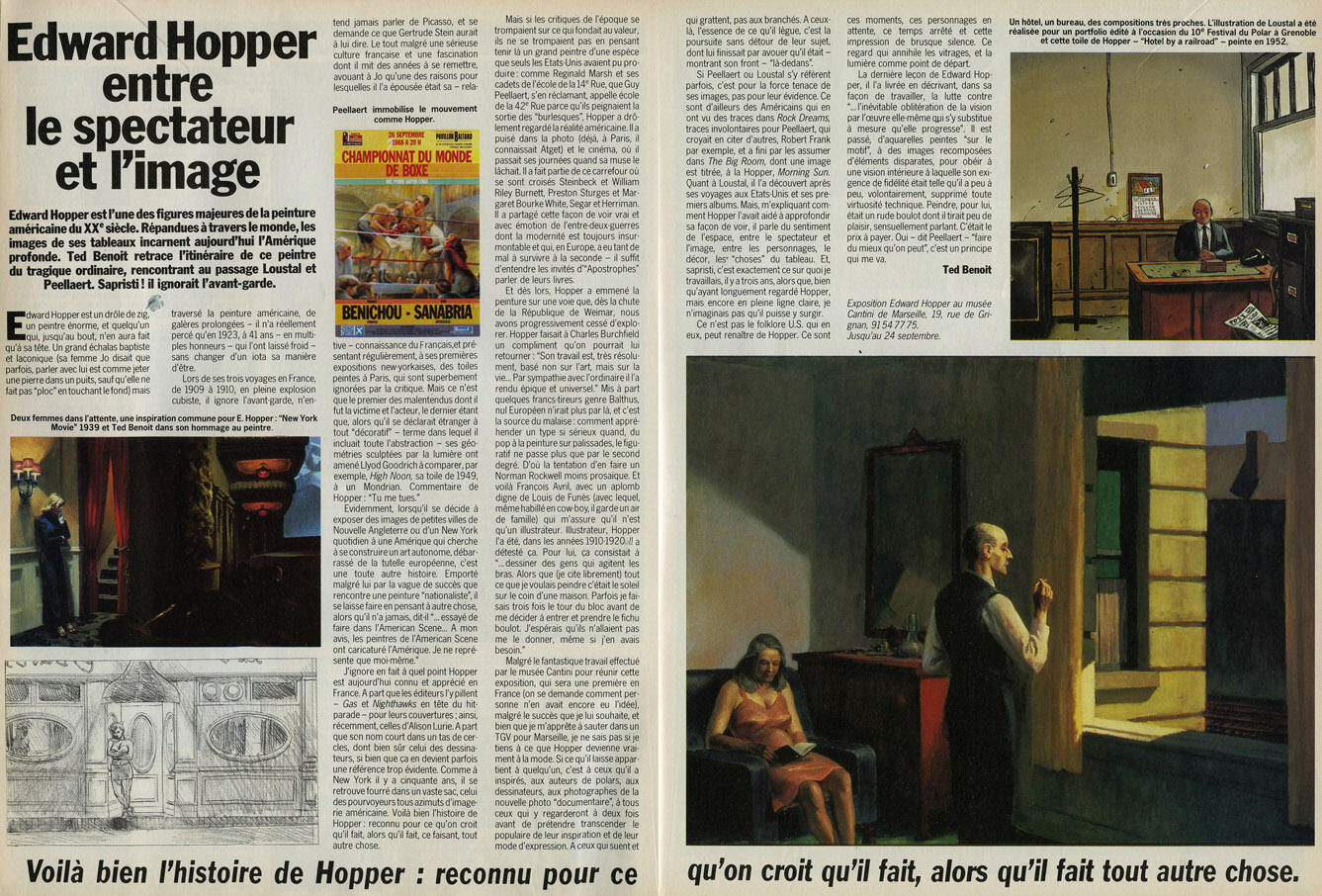
1989 08 A suivre N139s
|
|
|
|
|
Nighthawks is one of the few pictures about which the taciturn
painter Edward Hopper ever spoke. Nighthawks, he said, was his
vision of a street at night: not necessarily something especially
lonely - a restaurant in Greenwich Avenue at the junction between
two roads. "I simplified the scene and made the restaurant
bigger. Unconsciously, probably, I painted the loneliness of a big
city...." Critics have compared the atmosphere of Nighthawks
with that of some of Ernest Hemingway's short stories, which
Hopper loved. In March 1927, when Hopper discovered Hemingway's
story "The Killers" in Schribner's Magazine - for which
the artist occasionally worked as an illustrator - he wrote:
"It is refreshing to stumble upon such an honest piece of
work in an American magazine, after wading through the endless
stodge of which most of our modern literature consists. In this
story, no concessions are made to popular taste, there is no
deviating from the truth, no contrived happy end." The two
people at the bar do not have much to say to each other. The man
with the face of a predatory bird - the nighthawk himself - might
be a real good-for-nothing straight out of a film noir, as
embodied by the laconic figure of Humphrey Bogart. (He too had to
do with a strange bird: Dashiel Hammet's Maltese Falcon.) This
man, his hat drawn, true to style, deep over his face, holds a
cigarette in his right hand. Unintentionally almost, he touches
the left hand of the woman, who is scrutinizing the fingernails of
her right hand. Or is she holding a scrap of paper with a
telephone number? At any moment she might toss it away. The
barkeeper - is he really the barkeeper, or just a waiter who
happens to be washing up? - seems to have made some harmless
remark as he is in the habit of doing to entertain his customers:
"It's been a long day," maybe, or "Been working
late this evening, huh?" Something that requires no answer.
Then there is another man, a lone wolf, who weighs his glass (of
whiskey?) thoughtfully in his hand. This is Hopper's "silent
witness." How does it go on from there? That remains an open
question. In Hopper's work, as in Hemingway's story, there is no
real solution, and certainly not some bogus ending. Edward Hopper
is one of the most important Realists of the 20th century, and not
only in the U.S.A. He never had to go in search of specifically
American themes. They were part of him. What moved him was the
condition humaine, the make-up of people in his country and in the
age in which he lived. W. Sch. Edward Hopper 1882 Edward Hopper is born on July 22 in Nyack, NY 1899-1900 Attends the Correspondence School of Illustrating in
New York 1900-06 Studies graphics and illustration at the New York
School of Art under Robert Henri and Kenneth Hayes Miller 1906-10 Travels to Europe 1910 Returns to the U.S.A.; works as an advertising illustrator 1913 Participates in the `Armory Show' in New York 1915 First etchings 1919 Exhibition in the Whitney Club, NY 1920 First solo exhibition, in the Whitney Studio Club, NY 1929 Takes part in the exhibition "Paintings of Nineteen
Living Americans" in the Museum of Modern Art, NY 1930 Moves to Cape Cod 1932 Turns down an offer of membership at the National Academy
of Design 1933 Retrospective at the Museum of Modern Art, NY 1943 Travels to Mexico 1950 Awarded an honorary doctorate from the Art Institute of
Chicago; retrospective in the Whitney Museum of American Art, NY
1951-52 Travels to Mexico 1953 Publication of the journal Reality 1955 Becomes a member of the American Academy of Arts and
Letters 1964 Retrospective in the Whitney Museum of American Art, NY 1967 Dies on 15 May
|
